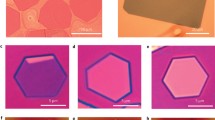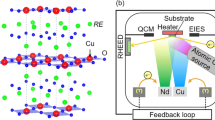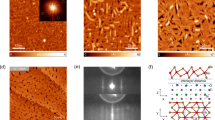Abstract
Two-dimensional (2D) superconductors have intriguing physical properties and abundant potential applications. Recently, 2D superconducting α-Mo2C and facecentered cubic Mo2C have been controllably prepared and they bring new viewpoints to carbon-based superconductivity. Although molybdenum carbides (Mo-Cs) have multiple crystalline stacking orders, there are still few structures reported for the lack of higher energy supply during growth. In this study, we report a two-step vapor deposition method to grow superconducting η-Mo3C2 films with different thicknesses, with the assistance of controllable plasma power. The grown η-Mo3C2 films show polycrystalline characteristics, but they still present superior superconductivity. The 3.0-nm-thick film has the superconducting transition temperature of 5.38 K, and its electrical performances follow truly 2D superconducting transitions. This study will not only exhibit a robust superconducting η-Mo3C2 ultrathin film, but also provides a convenient growth way to realize more carbide-based heterostructures for future device applications.
摘要
二维超导体具有丰富的物理特性和非常广泛的潜在应用. 最近, 有报道制备出具有二维超导特性的α-Mo2C和面心立方Mo2C,这些材料为碳基超导的研究带来了新的方向. 碳化钼具有多种晶体结构, 除了目前已经被制备的种类外, 二维碳化钼尚没有新的晶体结构被制备出来, 这或许是因为在制备过程中缺乏额外的能量供给. 在本工作中, 我们进一步发展了两步气相沉积法, 通过有效调控等离子体作为外加能量供给, 成功制备出具有不同厚度和超导特性的二维η-Mo3C2薄膜. 虽然这种方法生长出的η-Mo3C22薄膜是多晶, 但这些薄膜仍然可以表现出良好的超导特性. 其中,3.0 nm厚的薄膜具有5.38 K的超导转变温度, 而且其电学性能很好地与二维超导特性吻合. 这项工作不仅证明了二维η-Mo3C2薄膜具有稳定和良好的超导特性, 而且还提供了一种更为便捷的生长方法, 这将进一步促进更多基于二维碳化物异质结构的应用性器件的便捷制备.
Similar content being viewed by others
References
Saito Y, Nojima T, Iwasa Y. Highly crystalline 2D superconductors. Nat Rev Mater, 2017, 2: 16094
Shalnikov A. Superconducting thin films. Nature, 1938, 142: 74–74
Jaeger HM, Haviland DB, Goldman AM, et al. Threshold for su¬perconductivity in ultrathin amorphous gallium films. Phys Rev B, 1986, 34: 4920–4923
Guo Y, Zhang YF, Bao XY, et al. Superconductivity modulated by quantum size effects. Science, 2004, 306: 1915–1917
Ge JF, Liu ZL, Liu C, et al. Superconductivity above 100 K in single-layer FeSe films on doped SrTiO3. Nat Mater, 2015, 14: 285–289
Staley NE, Wu J, Eklund P, et al. Electric field effect on super¬conductivity in atomically thin flakes of NbSe2. Phys Rev B, 2009, 80: 184505
Xi X, Wang Z, Zhao W, et al. Ising pairing in superconducting NbSe2 atomic layers. Nat Phys, 2016, 12: 139–143
Novoselov KS, Geim AK, Morozov SV, et al. Electric field effect in atomically thin carbon films. Science, 2004, 306: 666–669
Cao Y, Fatemi V, Fang S, et al. Unconventional superconductivity in magic-angle graphene superlattices. Nature, 2018, 556: 43–50
Willens RH, Buehler E, Matthias BT. Superconductivity of the transition-metal carbides. Phys Rev, 1967, 159: 327–330
Fink HJ, Thorsen AC, Parker E, et al. High-field superconductivity of carbides. Phys Rev, 1965, 138: A1170–A1173
Xu C, Wang L, Liu Z, et al. Large-area high-quality 2D ultrathin Mo2C superconducting crystals. Nat Mater, 2015, 14: 1135–1141
Geng D, Zhao X, Li L, et al. Controlled growth of ultrathin Mo2C superconducting crystals on liquid Cu surface. 2D Mater, 2017, 4: 011012
Geng D, Zhao X, Chen Z, et al. Direct synthesis of large-area 2D Mo2C on in situ grown graphene. Adv Mater, 2017, 29: 1700072
Wang L, Xu C, Liu Z, et al. Magnetotransport properties in high-quality ultrathin two-dimensional superconducting Mo2C crystals. ACS Nano, 2016, 10: 4504–4510
Lee SJ, Ketterson JB. Critical sheet resistance for the suppression of superconductivity in thin Mo-C films. Phys Rev Lett, 1990, 64: 3078–3081
Anasori B, Lukatskaya MR, Gogotsi Y. 2D metal carbides and nitrides (MXenes) for energy storage. Nat Rev Mater, 2017, 2: 16098
Matthias BT, Hulm JK. A search for new superconducting com¬pounds. Phys Rev, 1952, 87: 799–806
Morton N, James BW, Wostenholm GH, et al. Superconductivity of molybdenum and tungsten carbides. J Less Common Met, 1971, 25: 97–106
Kolel-Veetil MK, Qadri SB, Osofsky M, et al. Size-induced effects on the superconducting properties of Mo2C nanoparticles. J Phys Chem C, 2007, 111: 16878–16882
Yamaura K, Huang Q, Akaishi M, et al. Superconductivity in the hexagonal-layered molybdenum carbide ?-Mo3C2. Phys Rev B, 2006, 74: 184510
Zhang F, Zhang Z, Wang H, et al. Plasma-enhanced pulsed-laser deposition of single-crystalline Mo2C ultrathin superconducting films. Phys Rev Mater, 2017, 1: 034002
Lin H, Zhu Q, Shu D, et al. Growth of environmentally stable transition metal selenide films. Nat Mater, 2019, 18: 602–607
Radisavljevic B, Radenovic A, Brivio J, et al. Single-layer MoS2 transistors. Nat Nanotech, 2011, 6: 147–150
Ferrari AC, Basko DM. Raman spectroscopy as a versatile tool for studying the properties of graphene. Nat Nanotech, 2013, 8: 235–246
Li T, Luo W, Kitadai H, et al. Probing the domain architecture in 2D a-Mo2C via polarized Raman spectroscopy. Adv Mater, 2019, 31: 1807160
Taghizadeh A, Leffers U, Pedersen TG, et al. A library of ab initio Raman spectra for automated identification of 2D materials. Nat Commun, 2020, 11: 3011
Xu C, Song S, Liu Z, et al. Strongly coupled high-quality graphene/ 2D superconducting Mo2C vertical heterostructures with aligned orientation. ACS Nano, 2017, 11: 5906–5914
Zhang Z, Zhang F, Wang H, et al. Substrate orientation-induced epitaxial growth of face centered cubic Mo2C superconductive thin film. J Mater Chem C, 2017, 5: 10822–10827
Ge Y, Ma S, Bao K, et al. Superconductivity with high hardness in Mo3C2. Inorg Chem Front, 2019, 6: 1282–1288
Hirakawa A, Makise K, Kawaguti T, et al. Thickness-tuned su¬perconductor-insulator transitions in quench-condensed Mo and MoRu films. J Phys-Condens Matter, 2008, 20: 485206
Lei J, Kutana A, Yakobson BI. Predicting stable phase monolayer Mo2C (MXene), a superconductor with chemically-tunable critical temperature. J Mater Chem C, 2017, 5: 3438–3444
Reyren N, Thiel S, Caviglia AD, et al. Superconducting interfaces between insulating oxides. Science, 2007, 317: 1196–1199
Kosterlitz JM, Thouless DJ. Ordering, metastability and phase transitions in two-dimensional systems. J Phys C-Solid State Phys, 1973, 6: 1181–1203
Geim AK, Grigorieva IV. Van der Waals heterostructures. Nature, 2013, 499: 419–425
Acknowledgements
This work was supported by the National Key R&D Program of China (2018YFA0305800), the Fundamental Research Funds for the Central Universities (020414380145 and 020414380153), the National Natural Science Foundation of China (11674154, 11761131010, 51972163, 11904163, 61974021 and 11525415), the Natural Science Foundation of Jiangsu Province (BK20190010), and the Fok Ying-Tong Education Foundation of China (171038). We thank Xiaoxiang Xi for help with electrical measurements by the superconducting magnet of 12 T.
Author information
Authors and Affiliations
Contributions
Gao L conceived and supervised the project, and designed the experiments. Shi W, Yu J and Xu J carried out the growth experiments and XPS, Raman and electrical measurements. Huang X and Liu W assisted in the electrical measurements. Tu X and Sun L performed TEM. Gao L, ShiWand Yu J wrote the manuscript, Xu J, Xu T and Sun L revised it, and all authors commented on it.
Corresponding author
Additional information
Conflict of interest
The authors declare no competing financial interests.
Wei Shi received his bachelor degree from Nanjing University in 2016. Now, he is a master candidate under the supervision of Prof. Libo Gao at the School of Physics, Nanjing University. His research interest focuses on the controllable growth of 2D carbide materials.
Libo Gao is a professor at the School of Physics, Nanjing University. He received his bachelor degree from Dalian University of Technology and PhD degree from the Institute of Metal Research, Chinese Academy of Sciences. He worked as a research fellow at Graphene Research Center, National University of Singapore from 2011 to 2015. Since 2015, he has been working in Nanjing University as a full professor. His scientific interests focus on controllable preparation and physical properties of 2D materials.
Electronic supplementary material
Rights and permissions
About this article
Cite this article
Shi, W., Yu, J., Xu, T. et al. Superconductivity in two-dimensional η-Mo3C2 films. Sci. China Mater. 64, 664–672 (2021). https://doi.org/10.1007/s40843-020-1459-x
Received:
Accepted:
Published:
Issue Date:
DOI: https://doi.org/10.1007/s40843-020-1459-x




